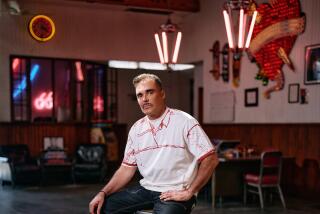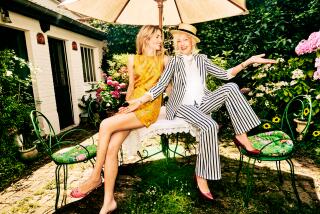JOHN BRYSON CAPTURES THE MOVERS AND THE SHAKERS
- Share via
When Dr. Armand Hammer wanted to talk to one of his Occidental Petroleum executives who was sailing, he sent a helicopter to drop a bottle with a message inside to call headquarters. Another employee, traveling cross country, once was stopped by a gas station attendant with instructions to phone the boss.
Still, photographer John Bryson was surprised when the tenacious tycoon reached him in an Indian town where the telephone system was so tenuous that foreigners flew to New Delhi to place international calls. Hammer had scheduled a trip to China and wanted to know when Bryson would be back in the United States; his staff worked for three days to get the photographer on the phone.
“He’s a real pistol,” said Bryson, who has spent the past three years as Hammer’s “photographic Boswell,” as the industrialist has dubbed him. In “The World of Armand Hammer” (Harry Abrams: $35), Bryson has chronicled the near-legendary millionaire’s life as business magnate, statesman, philanthropist, art collector and horse breeder--as a man who, Bryson writes, “has everything and has done everything.”
In 250 color pictures and text, Bryson records Hammer taking tea at 10 Downing Street, meeting with Chinese leader Deng Xiaoping in Beijing’s Great Hall of People, and chatting with Soviet chief Mikhail Gorbachev in his private office. Bryson estimates that he flew a million miles with Hammer, who, he notes, “travels between continents like most people go back and forth to the corner store.”
When his coffee-table opus was completed, Bryson put it on the bathroom scales. “It weighed five pounds,” he said, laughing, as he sat on the porch of his Malibu beach house, where he lives with his wife, actress Nancy Guild.
Though John McEnroe was jogging along the strand, Bryson noted that he doesn’t impinge on the privacy of famous locals. “I don’t take people picking their nose,” he said.
Hammer consented to be photographed because, Bryson said, “he trusted me.” The book grew out of a Life magazine story on Hammer, which followed a pictorial essay on the private life of Katharine Hepburn.
Bryson portrayed Hepburn at her Connecticut family house, pruning trees, cooking chicken and studying a script with her hair in curlers. In his 30 years as a photojournalist, Bryson has snapped Hemingway kicking a beer can in the snow (“Papa’s” favorite picture of himself), clicked Salvador Dali with a crown of sausages on his head and commanded $20,000 from Life for a picture piece on Marilyn Monroe.
Bryson’s office at home is virtually wall-papered with magazine covers. There are autographed photos of the world-renowned and pictures of the photographer posing with a gamut of notables from Castro to Franco.
Bryson views his celebrated subjects amicably. “I don’t think I’m a lap-dog photographer, but I’ve orbited around them, and I’ve had a lot of har-d-hars with them,” he said.
He likes to tell about the night he got drunk with John Wayne and the salty words they exchanged, and how he and Hemingway downed an estimable quantity of spirits together.
He even admits to liking Franco, whom he photographed in his avocation as amateur painter, standing in his studio before a work-in-progress, a Currier & Ives-like canvas of a clipper ship. “I couldn’t believe that this was the butcher of Guernica,” he said.
Bryson has poked his lenses into private worlds, using a combination of chutzpah and charm. Nicknamed “the papa bear,” he’s a big, shambling man with a walrus mustache and horn-rimmed glasses the size of dinner plates. He advances with the gait of a charging grizzly. Dress him in a trench coat, and Bryson becomes the prototypal photojournalist straight from a starring role in the ‘50s--which is the route he followed.
Recruited by Life before he was graduated from the University of Texas, Bryson spent an eight-year stint on the publication as a journalist and picture editor. It was he who sent Robert Capa on his last assignment in Indochina, where he was killed by a land mine.
In 1955, Bryson set out on his own as a photographer, with Life magazine as a steady client. These were days when big names could demand quadruple rates and space often meant 15 pages. It was an era of big picture publications--Life, Look, Holiday--before television devoured the image market.
“At Life, the photographer was really king,” Bryson said. “You were your own editor. If you shot a story a certain way, that’s the way it was used.”
As for the pictures, he said, “You didn’t need to read the captions.” Bryson continues to go after illustrative photographs, sometimes sketching out a shot before he takes it. When possible, he works with natural light, and he never uses an assistant.
With a bicoastal life, a whitewashed beach house, a Mercedes convertible and a Vuitton camera case as accouterments, Bryson keeps admirably abreast of the peerage he photographs. Except, of course, for Hammer.
When the two appeared together recently on “The Tonight Show,” they were both paid $200. “I told Dr. Hammer I hoped we would continue to make the same money,” Bryson said.
Bryson spoke of Hammer laudably, calling him “a friend,” a man who likes to joke or can sit in silent concentration, coast to coast, in his private Boeing 727. Hammer’s most private moments are in the plane, Bryson said, when he and Frances Hammer, his 83-year-old wife, watch their favorite Charlie Chaplin movies as they sit hand-in-hand and giggle.
There are no pictures of such intimacies, though there is an array of informal shots of the magnate playing with his million-dollar Arabian stallion, watching four TV sets as he lies in bed, and of Frances Hammer painting in the studio of their Westwood home. (Her copies of masterpieces, Bryson writes, sometimes hang on the walls, replacing the originals that are on loan to museums.)
One of Bryson’s favorite pictures is a close-up of former Soviet leader Konstantin Chernenko greeting Hammer. “You can see a real spark of affection in his face,” he said. His most exciting treks were to Gorbachev’s private office, which he describes as plain and functional, and to Lenin’s office, preserved in the heart of the Kremlin, where Hammer posed beside the desk of the man who granted him his first Soviet business deal.
Personal glimpses of Hammer’s whirlwind existence were caught in passing snatches. At Moscow’s Pushkin Museum, Frances Hammer said to Guild, “Keep an eye on the doctor. Sometimes he forgets me.”
More to Read
Sign up for our Book Club newsletter
Get the latest news, events and more from the Los Angeles Times Book Club, and help us get L.A. reading and talking.
You may occasionally receive promotional content from the Los Angeles Times.










